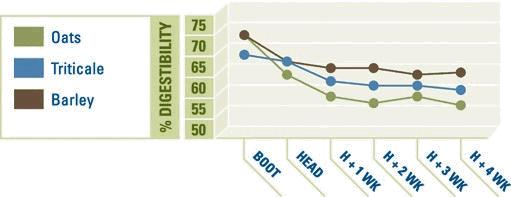| |
Silage Management Questions - Frequently Asked Questions | |
| |
|
|
| |
|
|
| | What crops are used for cereal silage?
The most common cereals for silage in Alberta are barley or oats. Spring triticale is gaining wider acceptance for its role as both a silage crop and as a rotation crop in silage production systems. Plant breeding efforts are leading to the development of newer cultivars of spring triticale, winter triticale and oats with improved forage quality for silage production.
When do you cut cereal crops for maximum silage yield?
The general rule has been to leave the cereal crop until the mid to soft dough stage or about 3 to 4 weeks after heading. For silage harvesting, the dough stage has been a good indicator of potential crop yield. As shown in Figure1, 80 to 90% of the maximum yield is obtained when crops like oats, barley or spring triticale reach the dough stage.
Does the stage of maturity effect silage moisture content?
For cereal silage the moisture content should be 60 to 65 % when it is delivered to the pit. This moisture level will permit both good packing and fermentation. In cereal crops, dry down begins shortly after heading and accelerates with kernel development. For both barley and oats the moisture content of the standing crop can reach 65% by the late milk to early dough stage. Harvesting at earlier stages such as the milk or early dough will help in avoiding the problem of the silage becoming too dry for proper packing and ensiling.

Figure 1. Per cent of total yield as crop matures, for oats, barley and triticale.
Source: Silage Manual , Alberta Agriculture, Food and Rural Development, Agdex 120/52-2
Does crop maturity impact silage digestibility ?
As cereal crops mature the portion of the silage biomass that is leaf material declines while the stem and seed –head portions increase. As a result, silage protein levels decrease and fiber levels increase. As shown in Figure 2, this decline in digestibility does vary by crop species. When compared to oats or spring triticale, barley has a higher level of forage digestibility at all stages of maturity. Oats and triticale on the other hand have a more rapid decline in digestibility with maturity. Spring triticale is intermediate between oats and barley at later stages of harvest. Aiming to harvest these crops at earlier stages of maturity will help in producing higher quality silage.

Figure 2. Silage digestibility (in vitro digestibility) as crop matures, for oats, triticale and barley.
Source: Silage Manual Alberta Agriculture Food and Rural Development, Agdex 120/52-2
How should winter cereals be managed?
Research with fall rye and winter triticale suggests that these crops have a more rapid rate of maturation after heading than spring cereals. They also appear to have a lower leaf to stem ratio. To offset this, these crops should be cut at the heading to flowering stage. This will produce a silage that is similar in feeding value to barley at the mid dough stage. Harvesting fall rye or current winter triticale cultivars at later stages of maturity (dough) will result in a silage with reduced digestibility and lower voluntary intake.
Where can I find further information on cereal silage production?
Further information on cereal silage production can be obtained by ordering the Silage Manual through the publication office of Alberta Agriculture and Rural Development by phoning 1 800-292-5697 (toll-free). Further information on the use of triticale can be obtained by requesting a copy of the Triticale Production Manual by phoning 780-674-8268. |
|
| |
|
|
| |
For more information about the content of this document, contact Karin Lindquist.
This document is maintained by Mary Ann Nelson.
This information published to the web on June 23, 2006.
Last Reviewed/Revised on August 20, 2018.
|
|